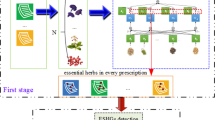Abstract
As a complementary system to Western medicine, Traditional Chinese Medicine (TCM) provides a unique theoretical and practical approach of treatment to diseases over thousands of years. Accompanying with the increasing number of TCM digital books in digital library, there is an urgent need to explore these resources by the techniques of knowledge discovery. We present a method for creating a network of herbs and partitioning it into groups of related herbs. The method extracts structured information from several TCM digital books, then a new method named Support and Dependency Evaluation (SDE) is presented for herbal combinational rule mining. The herbal network is created from the extracted dataset of paired herbs. The partitioning procedure is designed to extend FEC algorithm to deal with the weighted herbal network. Experiments demonstrate that the method proposed has the capability of discovering groups of related herbs.
Access this chapter
Tax calculation will be finalised at checkout
Purchases are for personal use only
Preview
Unable to display preview. Download preview PDF.
Similar content being viewed by others
References
Honda, K., Jacobson, J.S.: Use of complementary and alternative medicine among United States adults: the influence of personality, coping strategies, and social support. Preventive Medicine 40, 46–53 (2005)
Shi, S.M., Wei, B.G., Yang, Y.: Msuggest: a semantic recommender framework for traditional chinese medicine book search engine. In: CIKM 2009, pp. 533–540. ACM Press, Hong Kong (2009)
Ling_Join Software, http://www.lingjoin.com/download/LJParser.rar
Qiao, S.J., Tang, C.J., et al.: Mining the compatibility law of multidimensional medicines based on dependence model sets. Journal of Sichuan University(Engineering and Science Edition) 39(4), 134–138 (2007) (In Chinese)
Wang, Y.Q., Yu, Z.H., Jiang, Y.G., et al.: Automatic symptom name normalization in clinical records of traditional chinese medicine. BMC Bioinformatics 11, 40–50 (2010)
China Academic Digital Associative Library., http://www.cadal.zju.edu.cn
Feng, Y., Wu, Z.H., Zhou, X.Z., et al.: Knowledge discovery in traditional chinese medicine: state of the art and perspectives. Artificial Intelligence in Medicine 38, 219–236 (2006)
He, Q.F., Cui, M., Wu, Z.H., Zhou, X.Z., Zhou, Z.: Compatibility knowledge discovery in Chinese medical formulae. Chin. J. Inf. Tradit Chin. Med. 11, 655–658 (2004)
Zhou, X.Z., Liu, B.Y., Wu, Z.H., Feng, Y.: Integrative mining of traditional Chinese medicine literature and MEDLINE for functional gene networks. Artificial Intelligence in Medicine 41, 87–104 (2007)
Liu, X., Hong, W., Song, J., Zhang, T.: Using Formal Concept Analysis to Visualize Relationships of Syndromes in Traditional Chinese Medicine. In: Zhang, D. (ed.) ICMB 2010. LNCS, vol. 6165, pp. 315–324. Springer, Heidelberg (2010)
Clauset, A.: Finding local community structure in networks. Physical Review E (Statistical, Nonlinear,and Soft Matter Physics) 72(2) (2005)
Fortunato, S., Barthelemy, M.: Resolution limit in community detection. Proc. of the National Academy of Science 104(1), 36–41 (2007)
Yang, B., Cheung, W.K., Liu, J.: Community mining from signed social networks. IEEE Trans. on Knowledge and Data Engineering 19(10), 1333–1348 (2007)
Rumi, G., Kristina, L.: Community Detection using a measure of influence. In: Proc. SNA-KDD (2008)
Stephens, M., Palakal, M., Mukhopadhyay, S.: Detecting gene relations from Medline abstracts. Pac. Symp. Biocomput. 6, 483–496 (2001)
Newman, M., Girvan, M.: Finding and evaluating community structure in networks. Physical Review E 69(2), 26113 (2004)
Mei, J., He, S., Shi, G., Wang, Z., Li, W.: Revealing network communities through modularity maximization by a contraction-dilation method. New Journal of Physics 11(4) (2009)
Mitrovic, M., Tadi, B.: Spectral and dynamical properties in classes of sparse networks with mesoscopic in homogeneities. Physical Review 80(2), 026123 (2009)
Ren, W., Yan, G., Liao, X., Xiao, L.: Simple probabilistic algorithm for detecting community structure. Physical Review 79(3), 36111 (2009)
Clauset, A., Newman, M.E.J., Moore, C.: Finding community structure in very large networks. Physical Review 70(6) (2004)
Fortunato, S.: Community detection in graphs. Physics Reports 486, 75–174 (2010)
Yang, H.J., Chen, J.X., Tang, S.H., Li, Z.K., Zhen, Y.S., et al.: New drug R&D of traditional chinese medicine: role of data mining approach. Journal of Biological Systems 17(3), 329–347 (2009)
Author information
Authors and Affiliations
Editor information
Editors and Affiliations
Rights and permissions
Copyright information
© 2011 Springer-Verlag Berlin Heidelberg
About this paper
Cite this paper
Wang, L., Zhang, Y., Wei, B., Yuan, J., Ye, X. (2011). A Method for Finding Groups of Related Herbs in Traditional Chinese Medicine. In: Tang, J., King, I., Chen, L., Wang, J. (eds) Advanced Data Mining and Applications. ADMA 2011. Lecture Notes in Computer Science(), vol 7120. Springer, Berlin, Heidelberg. https://doi.org/10.1007/978-3-642-25853-4_5
Download citation
DOI: https://doi.org/10.1007/978-3-642-25853-4_5
Publisher Name: Springer, Berlin, Heidelberg
Print ISBN: 978-3-642-25852-7
Online ISBN: 978-3-642-25853-4
eBook Packages: Computer ScienceComputer Science (R0)




